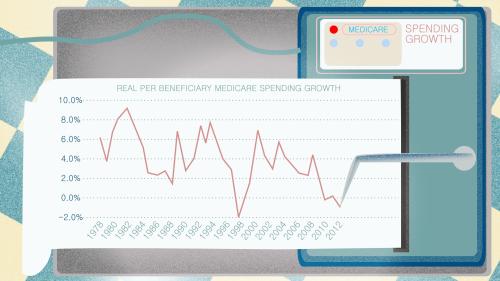Over the past year, the American economy has been gradually recovering from the Great Recession. The pace has been well below everyone’s hopes. Meanwhile, some elements of the Affordable Care Act have been put into effect. Against that background, what should one expect from the annual report of the Census Bureau on income, poverty, and health insurance coverage?
The answer is that one should not expect much: little change in income, possibly a minor reduction in poverty, and some slight increase in health insurance coverage. In some respects, that is what the Census Bureau reported. But not exactly, and some of the differences are disturbing.
The Good News: Health Insurance Trends
The one genuinely bright spot in the Census Bureau report today is the reversal of two worrisome trends: the steady increase in the number of uninsured and the steady drop in the number of people insured through work. Both trends reversed in 2011. With the admittedly modest bounce in employment from recession lows, employment-based coverage increased, even as the proportion insured through work continued its decade-long slide. For adults in the prime working ages, 25 through 54, the drop in employer-sponsored coverage has been large: from 73.8 percent in 2000 to 61.8 percent in 2011.
The number of people insured by one government program or another rose 5 percent to just under 100 million, an increase that accounted for most of the total gain in health insurance between 2010 and 2011. Since 2000, the proportion of the total population insured by a government program has risen by one-third.
In the last year, coverage of 18 to 24 year-olds increased. Much of that jump came because young adults remained on their parents’ insurance plans, abetted by one of the key provisions of the Affordable Care Act that has already taken effect.
Income Trends And The Role Of Health Spending
Each month for the past two years, the Bureau of Labor Statistics has reported modest increases in employment. Thus, it should surprise no one that the Census Bureau reports that the number of people with income from earnings also increased. Although employment rose, median earnings of people who worked full-time, all year dropped a jarring 2.5 percent between 2010 and 2011. In contrast, average income rose a bit. Hammered by two recessions, both income measures remained well below levels reached in 2000. In fact, median income is virtually the same as it was in 1989.
With average and median income moving in opposite directions, it follows that inequality increased. The share of income received by the middle 60 percent of the population dropped and the share received by the top 5 percent rose by 5 percent. These data underscore the plight of the middle class, a theme of the recent political conventions.
The 2011 Census Bureau report provides no solace to those concerned about the problems of people who live in poverty. The absolute number of people in poverty is almost unchanged. The fraction who are poor fell 0.1 percentage points. Scanning the long-term trend in the proportion of the U.S. population living in poverty is deeply depressing. Nearly four decades ago, in 1974, the proportion of American living in poverty reached a low of 11.1 percent. There has been little good news since. Poverty increased after 1974 then fell during the booming 1990s, dropping to 11.3 percent in 2000. Two recessions later the rate is back up to 15 percent.
These numbers tell a story that is simple and, for most Americans, sad: poverty has increased, the middle class has stagnated, and the wealthy have become richer.
As those who have studied income data know well, measuring poverty is extremely difficult and fraught with ambiguity. In fact, the Census Bureau provides several measures of poverty. The traditional poverty measure makes no adjustment for out-of-pocket medical expenses, even though most are involuntary and reduce funds available for ordinary living expenses. An experimental measure subtracts out-of-pocket medical expenses and makes some other adjustments as well.
How health care spending is treated has a dramatic effect on the proportion of various age groups counted as poor. The cost of health care has increased hugely over time. So has health care’s contribution to well-being. Because health care spending rises sharply with age, these trends have simultaneously boosted the well-being of the elderly relative to other age groups and placed an increased financial burden on them. The proportion of those over age 65 counted as poor is dramatically higher under the experimental measure, which subtracts out-of-pocket medical expenses from income used in measuring poverty, than it is under the traditional measure. The proportion of those 18 or younger counted as poor under the experimental measure is lower than under the traditional measure.
How should one interpret these differences? Over time, the elderly, as disproportionate users of health care, benefit disproportionately from the increase in the value of those services. But if one subtracts out-of-pocket medical expenses from available resources, that adjustment pushes up trends in the poverty rate of the elderly relative to that of younger people. On the other hand, if one focuses on a single point in time, it remains true that out-of-pocket medical spending is mostly involuntary and is unavailable for the purchase of all other goods and services.
Accordingly, measures of poverty suffer from an inescapable conceptual ambiguity. The traditional measure of poverty, which does not subtract out-of-pocket spending on health care, provides a better indication of the trend of well-being for various age groups than does the experimental measure. But if one is interested in the relative well being of various age groups at a point in time, the experimental measure, which does subtract out-of-pocket medical spending, is the better measure. As one analyst quipped many years ago, ‘you can’t eat your wheelchair.’
The Work Ahead
Implicit in all of these statistics is the urgent need for the nation to undertake steps to speed economic recovery. Added demand for labor will push up earnings and employment. More employment will mean more people will receive health insurance as a fringe benefit. Although long-term trends in poverty are not encouraging, reductions in unemployment lower poverty. The grave risk is that as the duration of unemployment increases more and more workers will see their skills atrophy, to their personal cost and the nation’s loss. It did not take the recent Census Bureau report to reveal these risks and opportunities. But that report surely underscores them.



Commentary
Op-edThe New Census Numbers: Some Good News, But Major Challenges Remain
September 12, 2012